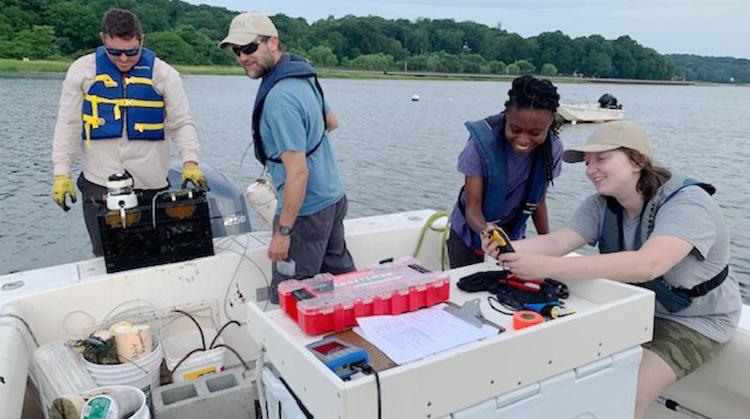
By UN Academic Impact (UNAI)
NEW YORK, 12 April 2023 (IDN) — Covering more than 70% of the planet, the oceans are arguably Earth’s most powerful resource. According to the National Aeronautics and Space Administration (NASA) of the United States, close to six hundred thousand kilometers of coastline edge them, and almost one-third of the world’s population—2.4 billion people—live within 160 kilometers of their shores. On that note, ocean degradation is one of humanity’s most compelling challenges, also addressed in the Sustainable Development Goal 14: Life below Water.
With this in mind, Dr. Aaren Freeman and Dr. Ryan Wallace, faculty members and researchers in the Biology and Environmental Studies and Sciences Departments at Adelphi University, a member institution of the United Nations Academic Impact (UNAI) in the United States, have spent several years studying the problem of nutrient pollution in our waters and proposing a set of viable and sustainable solutions. Nutrient pollution is an excess of nitrogen and phosphorous caused by various human activities.
Activities such as dumping chemical and natural fertilizers, sewage, and pesticides. Excess nitrogen is harmful to humans and stimulates the growth of large amounts of algae that choke narrow waterways and deplete oxygen in the water, thus harming marine life. Long Island Sound, a marine sound and tidal estuary of the Atlantic Ocean, is vulnerable because of the dense population, neighboring industry, public green spaces that rely on industrial fertilizers, and the shallowness of the bay waters.
As such, this is an ideal location for conducting scientific research aimed at stopping and reversing the degradation and restoring the coastal ecosystem. Adelphi’s researchers approached the issue from two different angles. One focus was the severe drop in the bivalve populations of Shinnecock Bay which, Dr. Wallace states, has been reduced by almost 95% through over-harvesting. “Bivalves like oysters and clams are known as ‘keystone species’ because they provide many ecological services,” the expert states.
“They are filter feeders, actively pumping water into their bodies and sorting particles out to feed on. So, the more bivalves you have, the fewer harmful algal blooms.” One adult oyster can actually filter almost two hundred liters of water per day. Dr. Freeman says they want to “bring back oysters as a food source and to remove excess nitrogen from the coastal ecosystem.” He says we can reap the dual benefit of feeding people and cleaning up the water. The objective is to provide how the ecosystem can rebuild itself naturally.
If the area could be repopulated with enough oysters, it would improve the water quality, reducing algal blooms and allowing marine life to thrive. Additionally, the food supply would be replenished. In 2016, Dr. Freeman co-founded the Community Oyster Restoration Project with several stakeholders. Volunteers collected oyster shells from area restaurants and oyster festivals to rebuild ersatz ‘reefs’ or ‘spawner sanctuaries’ in protected areas of the bay where the oysters can grow to maturity in a protected environment.
The project is ongoing, but already the results have been positive. Dr. Wallace commented: “We have observed an increase in oyster larvae settling within the bay and a subsequent increase in oyster abundance.” For example, at the beginning of the project, there were no quantifiable oysters inside the sanctuary in Laurel Hollow, and now there are thousands of them, even forming small reefs. In addition, a survey conducted by the town confirmed that the oyster population had risen significantly over the past five years.
For the second area of research, the two scientists address another way to mitigate the high levels of nitrates in the water by growing sugar kelp and re-introduce it to the community as a sustainable source of natural fertilizer. With the support of the towns of Hempstead and Oyster Bay, they began growing kelp and distributing it for use on local golf courses, thereby reducing the number of excess nutrients that would return to the bays. An advantage is that kelp absorbs substantial quantities of excess nitrogen from the water.
“We hope that using kelp instead of synthetic fertilizers will become more commonplace,” says Dr. Freeman. “There are many settings where this change makes sense not only to benefit the environment but also financially and for the health of our community,” he adds. The next immediate goal is for its use to be adopted in public playgrounds in the area. Equally important, the researchers feel strongly about how vital partnerships are and count on community engagement, without which change cannot be achieved.
“Community support for these efforts and outreach have been essential to building social license for these projects,” commented Dr. Freeman. Over the years, they have trained the next generation of environmental scientists by bringing Adelphi’s graduate and undergraduate students into their labs and the field, where they can often be seen at work along the shoreline. Outside of the university, Drs. Freeman and Wallace have worked with groups of citizen scientists engaged in oyster gardening during summer.
The project continues to grow as the community learns about the importance of this work to protect the Long Island bays, realizing that they, too, can be instrumental in bringing about change. And indeed, from its beginnings, the number of collaborators and partnering organizations has grown exponentially. Overall, the researchers’ work is significant. It provides scientists and communities with a successful case study on how environmental change is possible through thoughtful strategies grounded in scientific research. [IDN-InDepthNews]
Photo: The project is ongoing but already the results have been positive (Photo: Adelphi University)











